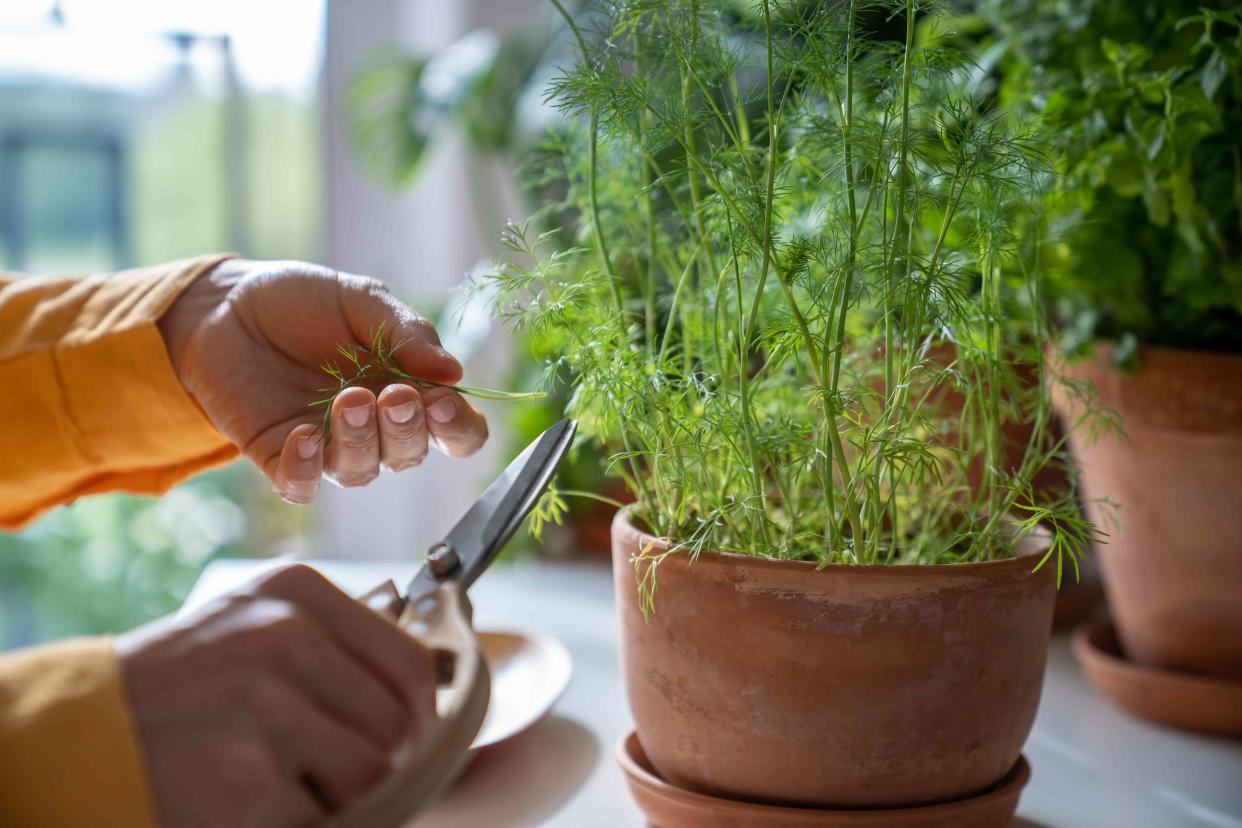How to Prune Dill: 3 Easy Ways

Dima Berlin / Getty Images
While its feathery foliage has a delicate appearance, dill is easy to grow and care for, and is an excellent addition to any garden. In addition to providing bright, fresh flavor for your dishes, dill plants also attract a host of beneficial insects such as ladybugs, green lacewings, and syrphid flies—all of which prey on aphids.
To keep your dill plant happy and healthy, it's important to regularly prune it. This will will help it grow bushier and fuller, promote new grow, and ultimately lead to a more abundant dill harvest.
Before You Get Started
No matter what method you use to prune your dill plant, it's important to keep these guidelines in mind.
Wait for the dill plant to have at least five leaves or until the plant is at least six inches tall, somewhere between four to eight weeks after planting.
As with other herbs, you should never trim more than one third of the entire plant.
To prevent over-pruning, allow the plant to recover and regrow to its previous size before pruning again.
If you prune down a stem without leaving any fronds (leaf sets), the stem will not grow more dill.
If you want the dill plant to continue growing its green foliage, pinch off any flower buds that form. Flowering is a sign that the plant is ready to reproduce and nearing the end of its life.
Every part of the dill plant is edible, including the seeds, stems, and flowers.
Want more gardening tips? Sign up for our free gardening newsletter for our best-growing tips, troubleshooting hacks, and more!
How to Prune Dill for Growth
If you're growing dill to use in your kitchen, pruning the plant can play a vital role in its yield. Regularly pruning away leaves from the top of the plant will encourage bushier growth—and give you fresh herbs to cook with.
I've found this is the best method to use for a bountiful dill harvest you can enjoy all season long. I follow this process when I need a few leaves to garnish a dish or salad with. I just run out back to my vegetable garden, pluck off a small handful of dill leaves, and bring them back into the kitchen to finish up.
Find a tender stem with mature growth.
Follow the tops of the fronds (dill leaves) to the previous leaf set. You'll want to prune right above it, leaving some leaves in tact for the stem to continue to produce leaves.
Using a clean pair of pruning shears, snip off the dill leaves from that top part of the stem. You can also use your thumb and forefinger to pinch the leaves off.
How to Prune Dill for Storage
If your goal is to harvest large amounts of dill for drying, freezing, or preserving, then you'll want to prune away much of the dill plant. Because the goal is no longer to encourage growth, you can cut the leaves, stems, and all. Dill is an annual plant and will need to be replanted the following year.
This is the pruning method I follow at the end of the growing season, when the dill plant is lush and full but doesn't have flowers blooming yet.
Spray the dill plant with water one day before harvesting it. This will help clear it of dirt and ensure the plant has moisture for the freshest harvest possible.
Using a pair of scissors or pruning shears, cut it at the base of the stem, pruning the whole plant away.
Place the stems in a glass of water like you would flowers.
If you plan to dry the dill, combine the dill stems into small bundles and hang them upside down to dry for one to two weeks.
How to Prune Dill for Seed-Saving
If you are growing a dill plant for its seeds, then you need to allow the plant to flower in order to harvest them. You can increase your seed crop by selectively pruning the leaves, forcing the plant to send all nutrients and energy to the seed-producing flowers.
In order to collect seeds, you want to encourage the dill plant to flower. Regularly prune the top leaves, making sure to leave the main stems intact.
Wait for your dill plant to start producing small yellow flowers. Allow the flowers to fully mature.
The seeds are ready to be harvested when the follows are brown and completely dried on the plant. To collect the seeds, secure a paper bag over the flower heads and shake them.
Once you are finished harvesting seeds, trim back the stems that held the flowers.
Frequently Asked Questions
How do you cut dill without killing the plant?
To allow dill stems to continue growing new leaves, it's important to leave a couple fronds (leaf sets). As a general rule of thumb, never prune more than one third of the dill plant at a time. Cutting off too much reduces its ability to recover and regrow.
Will dill grow back after being cut?
Yes. Dill is resilient and fast-growing. In fact, pruning dill regularly can encourage it to grow even more.
Should I let my dill flower?
Flowering is a sign that a plant is ready to reproduce and nearing the end of its life. If you want to continue harvesting dill leaves, you want to pinch off any flower buds that form so that it continues producing new growth. If you want to harvest dill seeds, you should allow the plant to flower so you can collect the seeds they produce.
Read Next: 12 of the Best Companion Plants for Dill, From Broccoli to Basil
Read the original article on The Spruce.

